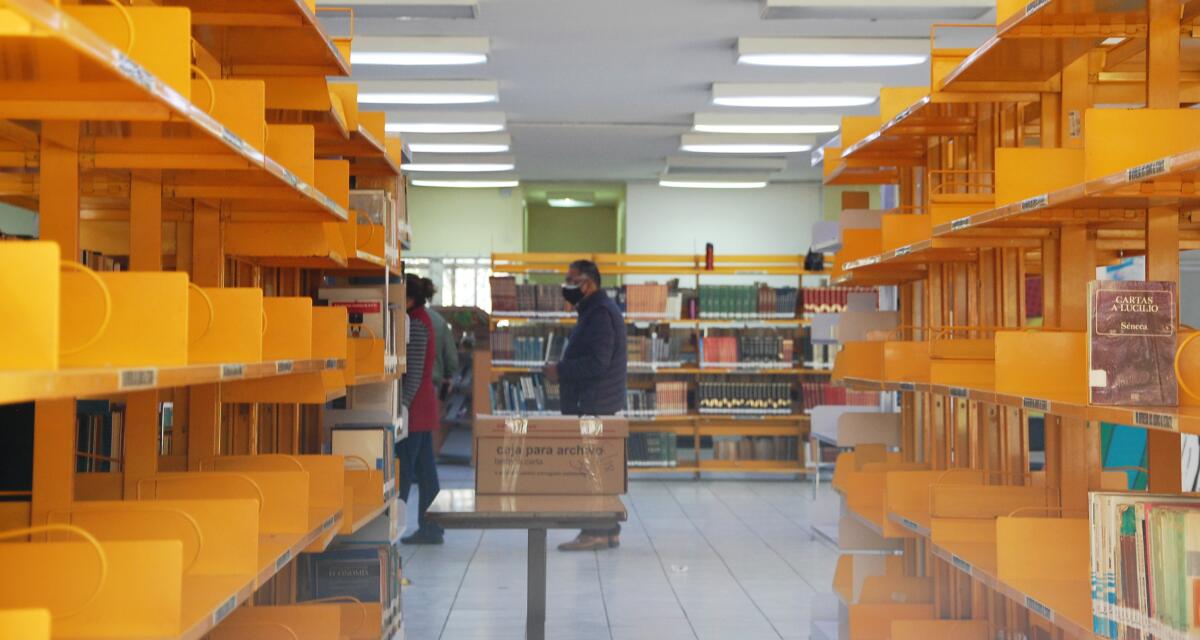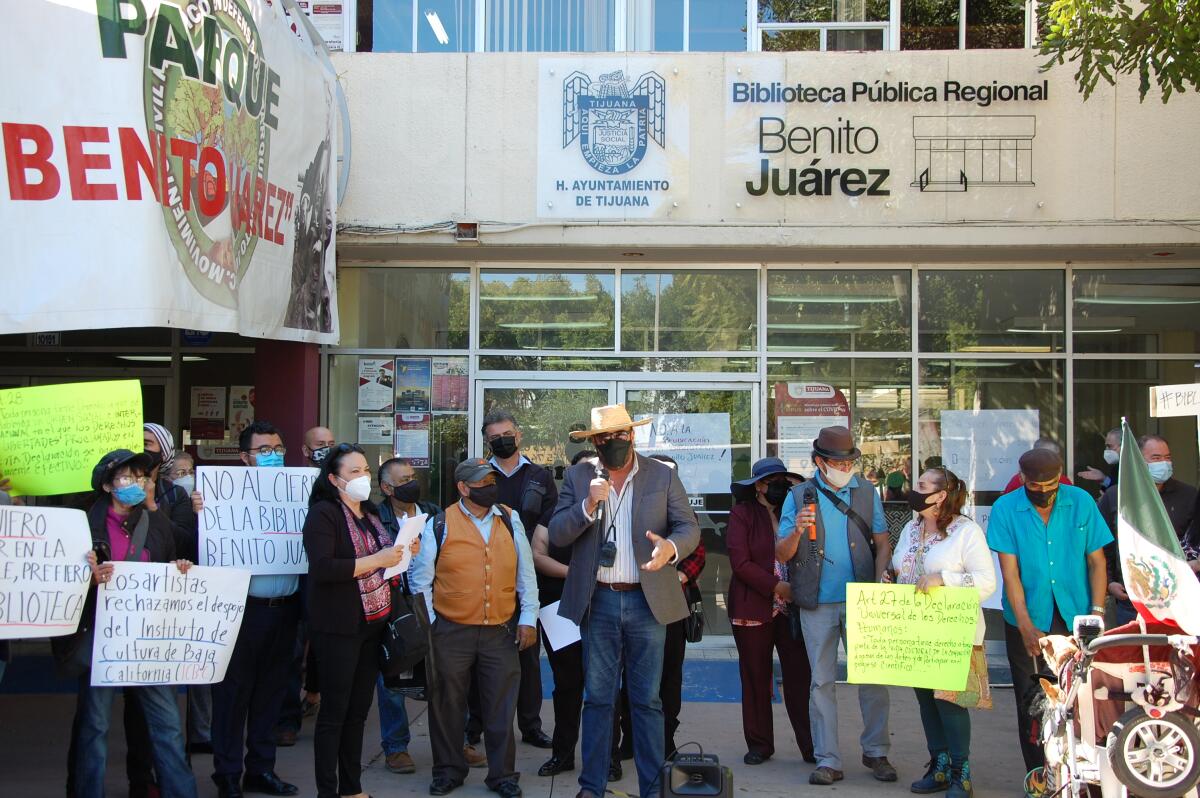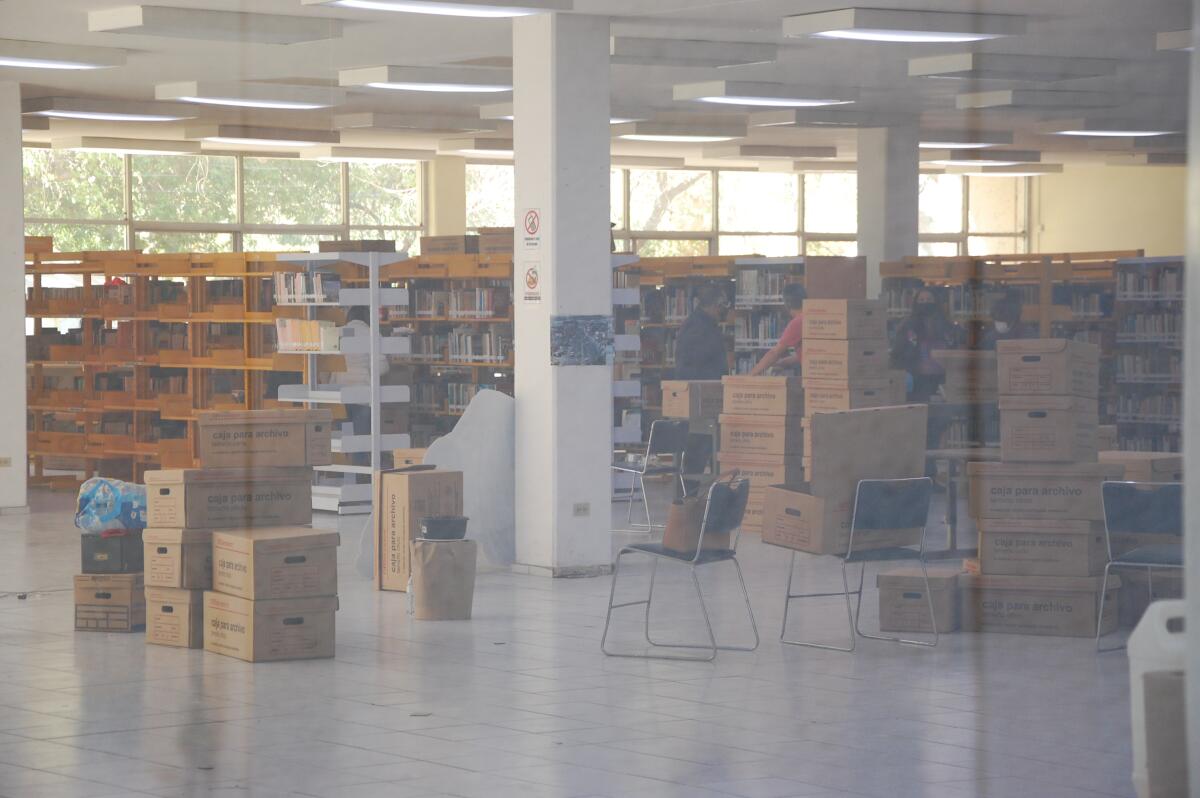Baja California government dismantles library in Tijuana, sparks discontent

- Share via
TIJUANA — As a result of the pandemic, Tijuana’s libraries are closed to the public; however, employees have been working virtually, and they occasionally visit the sites. But earlier this month, employees at the Benito Juárez public library, in Zona Río, were startled when other government employees arrived to evict them. The order, they said, came from Baja California Gov. Jaime Bonilla, and they were told to haul everything away in cardboard boxes.
That same day, Bonilla told Tijuana media that the city’s central library would be moved to a currently unused building, the former post office in the downtown area.
The library workers were surprised, but last November Bonilla publicly expressed his plans after becoming concerned with what he perceived as a lack of medical personnel, who are dealing with the pandemic crisis.
In 2020, on several occasions, Bonilla publicly said he was going to donate the state government headquarters in Tijuana — a three-story building next to the public library in Zona Río — to the Autonomous University of Baja California. He has said the building will be transformed into the university’s Center for Health Studies to expand the enrollment in health-related careers.
In mid-February, state government employees began to vacate the headquarters. Those working in the building were told that the offices would be moved to a nearby building where the library, the offices of the State Education secretary and the Baja California Institute of Culture are.
The Autonomous University of Baja California rector’s office declined a request to comment on the proposed donation. Currently, there’s no public document to back up the donation Bonilla promised.
The eviction of the library and the Institute of Culture facilities was criticized by some community members.
Benito Juárez Library
On the same day that the Centro Cultural Tijuana (Cecut) was inaugurated —October 20th, 1982— the then president of Mexico José López Portillo inaugurated the Benito Juárez public library, Tijuana’s second library. Today, the city has 24.
In 1988, the Rubén D. Luna Newspaper and Periodicals Library was added. The place archives store newspapers and printed publications dating from the 1930s to the present day.
The Benito Juárez library has a surface of 1338 square meters. It has more than 42 thousand books and other material, mostly donated by the General Directorate of Libraries, and special collections such as the Braille Collection, the Baja California Collection, and the Bilingual Literature Collection.
From 2017 to 2019, the average annual attendance at the Benito Juárez Library was 17,915 people.
Holding banners and shouting, “Library, yes! Offices, no!” dozens gathered Monday, outside the Benito Juárez library. Several speakers expressed their discontent and the lack of official information about what will happen to what they consider to be the largest library in Baja California.
Eunice Contreras, a cultural promoter in Tijuana, said that beyond the safekeeping of books, the library has a role within the community. She said the library also hosts several classes, like English language and adult education, children’s summer camps and literary events.
Contreras said that with the disappearance of the Institute of Culture space, the city loses a multipurpose stage with a capacity for 220 people, an amphitheater, a gallery and three exhibition halls for visual artwork.

Aída Méndez, one of the organizers of Monday’s demonstration, has been a resident of the Infonavit del Río housing complex since 2001. The complex, next to the library, has more than 70 multifamily buildings. Like other protesters, she said she supports the creation of new cultural spaces in Tijuana, but rejects the disappearance of the library and that library users’ opinions were never considered.
Another Tijuana resident and music promoter, Guillermo García, said that a few years ago he was able to finish high school and begin his undergraduate studies for free at the Benito Juárez library.
On social networks, several personalities from Tijuana’s cultural scene, including writers and artists in various disciplines, have expressed their displeasure about the move.
The day after the protest, the secretary of culture of Baja California presented the project for the Centro Cultural Correo, a space that would accommodate the library and other cultural services.
Pedro Ochoa Palacio, head of the secretary office, said the project is led by architecture students from the Instituto Tecnológico de Tijuana and that it is still in the design stage, and officials don’t know how much money will be needed to adapt and equip the building.
Ochoa and Bonilla said that the post office building is federal property, but Mexican President Andrés Manuel López Obrador agreed on an arrangement that will allow them to use the site.
The secretary of culture said the post office building, inaugurated in 1957, will undergo structural revisions. The office did not offer a timeline or an estimated cost. Bonilla’s administration ends Oct. 31.
There are at least two legal appeals, known as amparos (protections), filed in Federal Court to stop the eviction operation of the state government headquarters in Tijuana and the relocation of the library.

Bonilla said those opposing the move are against the creation of a new, modern cultural space. However, defenders of the Benito Juárez library and its building question whether the project will actually be completed in the remaining eight months of Bonilla’s administration.
More to Read
Sign up for Essential California
The most important California stories and recommendations in your inbox every morning.
You may occasionally receive promotional content from the Los Angeles Times.











